There's Beauty Under Those Ugly Leaves
It's that time of year when the overwintered kale, brussel sprouts, and sprouting broccoli look ragged, but they're about to become one of spring's pleasures. Plus, it's seasonal pesto time!
Brassicas make up a substantial part of our diet, from radishes and turnips to kale and broccoli, so it’s no surprise they dominate many vegetable gardens, mine included. They generally prefer cool weather and can tolerate frost, so they occupy most of kitchen garden and even some flower beds from fall to early spring.
Here’s what’s growing right now in my gardens and what I’ll be writing more about in late summer as I sow for next winter:
kale in the Brassica oleracea group (‘Nero di Toscana’, ‘Lerchenzunge’, ‘Halbhoher Grüner Krauser’, plus a purple curly kale from a friend’s garden)
kale in the Brassica napus group (‘Red Russian’, ‘Red Ruble’)
a kale + brussel sprout cross of my own
sprouting broccoli (‘Purple Sprouting Broccoli’, ‘Spigariello’)
various Asian mustards (‘Green in Snow’, ‘Mizuna’, ‘Red Frills’, ‘Green Frills’, ‘Red Giant’, ‘Purple Osaka’, ‘Wasabino’)
Asian greens (‘Mibuna’, ‘Chum Soy’)
annual arugula/rocket (Eruca sativa)
curly cress (Lepidium sativum)
Claytonia perfoliata
spinach
chard
several lettuce varieties (‘Maidivi’, ‘Red Oak’, ‘Forellenschluss’, ‘Flashy Lightning’, ‘Red Velvet’, to name a few)
The last four are the only cultivated species not belonging to Brassicaceae.
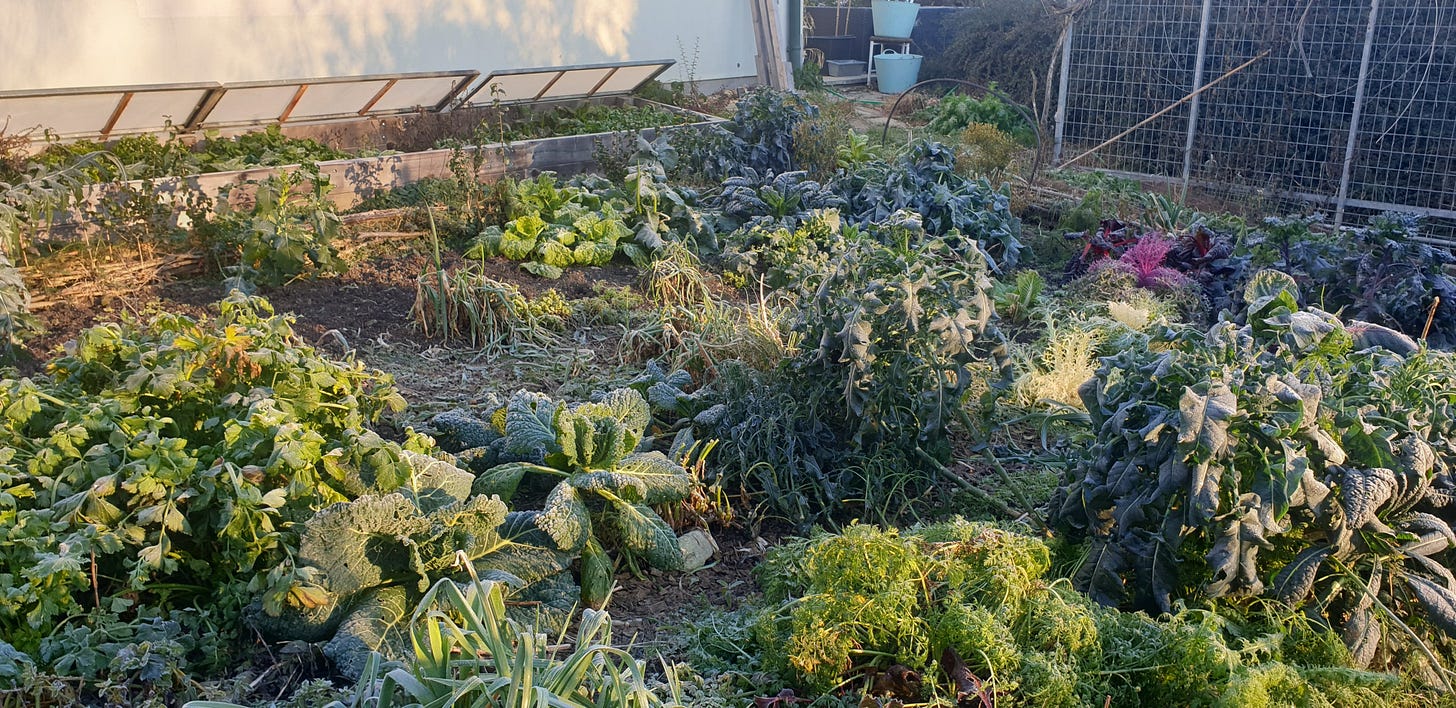
Although it might not seem so when their leaves sag and droop on frosty mornings, brassicas are masters at surviving winter. I’m sure passersby wonder why I allow them to clutter my garden when they look so sad, but I know their true beauty will show itself when they’ve made it through the darkest and coldest times to fulfill their destiny: reproduce. And that is about to happen right now. Under those drooping leaves, sprouts have been appearing, and they will soon blossom.

I don’t remove the spent leaves because they still serve a purpose; they protect the sprouts. I’ll remove them when the nights barely touch the freezing point. Left to develop, the sprouts will grow a stalk upward and build clusters of buds (the meaning of “broccoli” in Italian). That is exactly what I am so looking forward to. All of the brassicas produce edible flower shoots, but my favorites are sprouting broccoli, brussel sprouts, kale and Asian mustards. In fact, I grow brussel sprouts as much for the broccoli in spring as for the tiny round mini-cabbages in the winter.
If you’re wondering what variety that is in the picture of above, let’s call it “Tanja’s Flower Sprouts”. A few years ago, green and purple brussel sprouts crossed with Tuscan kale in my market garden and I ended up with a mish-mash of genetic diversity. I have no plans of selecting for breeding purposes; I just enjoy the surprises and the flavors.
The Chinese have a name for the flowering stalks of brassicas: soy chum (not to be confused with chum soy, a leafy green). I call them “spring broccoli”, a seasonal delicacy I have grown to love. They are tender and delicate in flavor, both raw and stir-fried.
Bolting is not always a bad thing.
Wild seasonal flavors
At this time in March, many wild edibles are emerging in my gardens. It is also prime foraging season for wild garlic. That means it’s time for the flavors of early spring: pesto mixes, spreads, salads, garnishes, salts, oils… the possibilities are endless.
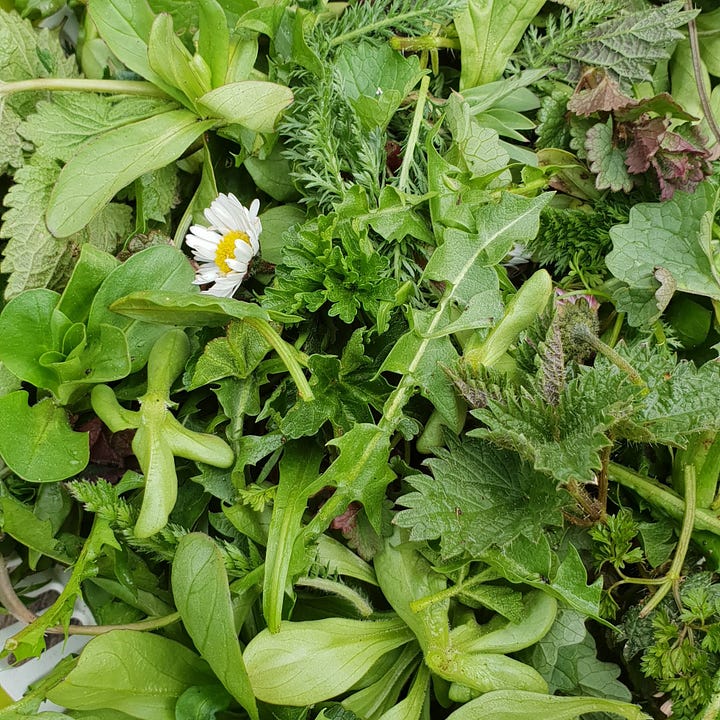
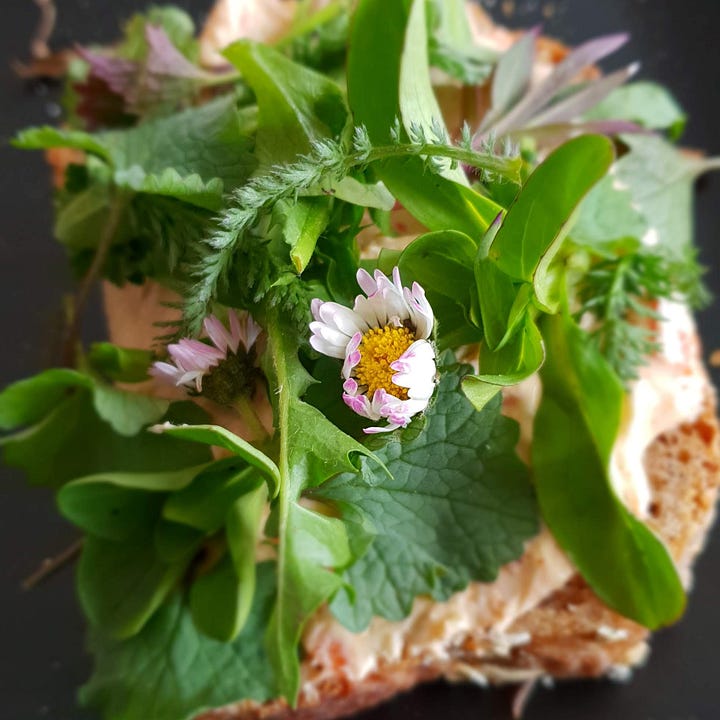
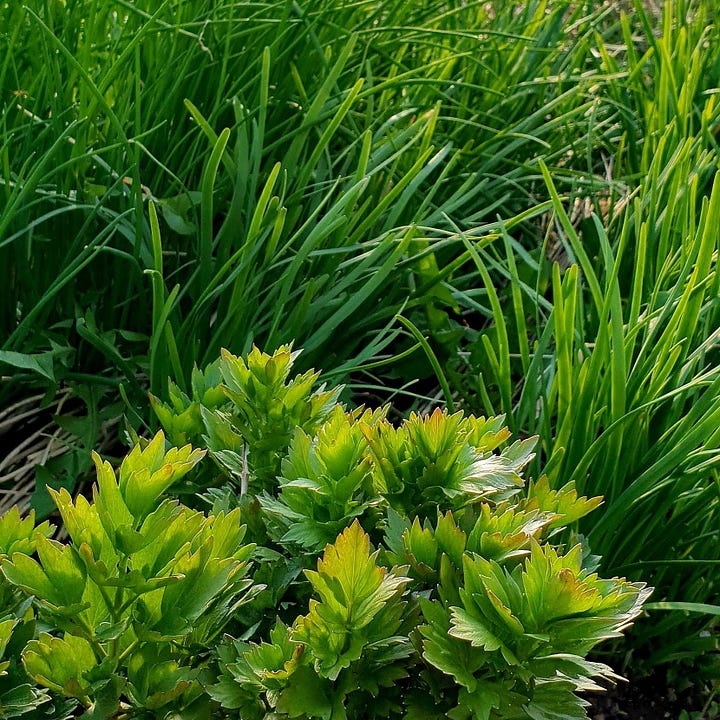
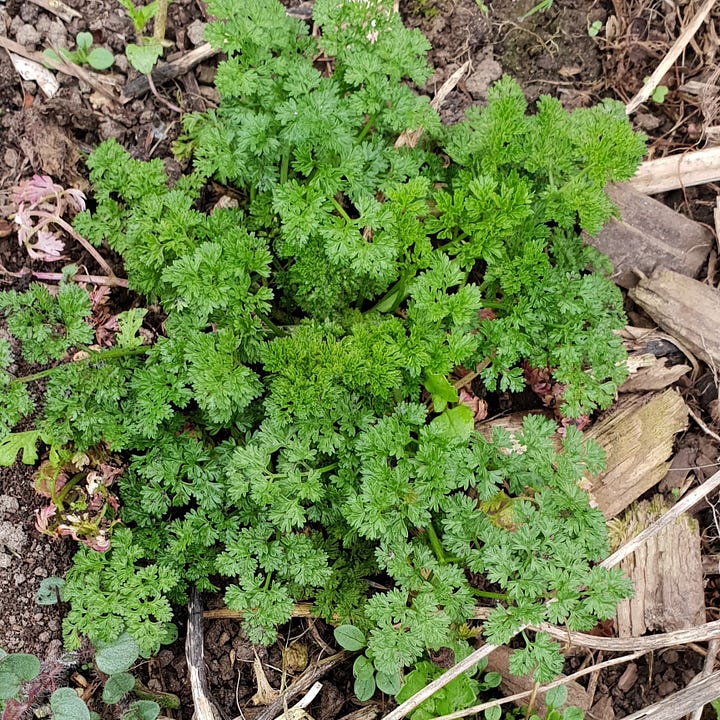
As for pesto mixes, when the herbs are especially aromatic, I sometimes choose a base such as corn salad, chickweed, or spinach to balance out the intensity. There’s no recipe, but it always involves a good handful of seasonal herbs (100 g / 3.5 oz.), 50 ml / 1/4 cup olive oil, juice of one lemon and salt and pepper. If I want nuts in it, I toast sunflower seeds and add them to the mix.
Wild herbs I like to use in early spring: ground ivy, yarrow, nettles, garden sorrel, wood sorrel, salad burnet, chickweed
Garden herbs in early spring: chives, garlic chives, oregano, chervil, mint
Obviously, I don’t use these all at once, but rather in complimentary combinations. There’s almost always a jar in the refrigerator as a quick seasoning for soups, sauteed vegetables, or salad dressings, a spread, and as pesto for pasta. It’s also excellent as a condiment for fish or meat, depending on the aromas.
Gardening tasks coming up:
I’ve managed to pot up the peppers and jalapenos. To save space and ease the workload, I prick them out and plant into a 48-cell flat. This year I was merciless and only potted up those with very healthy roots, which still turned out to be 4 flats. The cells are 5 cm / 2 in. wide, 7 cm / 2.75 in. deep. In about a month, I’ll pot them up to 9 cm / 3.5 in. pots. Meanwhile, the amount of shelf space and lugging I have to do for the next few weeks is greatly reduced, as I move them between the sunroom and the outdoors whenever the temperatures allow (8° C / 50° F and above).
Pepper varieties: ‘Csardasch’, ‘Sweet Chocolate’, ‘Hanik’, ‘Melrose’, ‘Splendid’, ‘Shishito’, ‘Orange Snack’, ‘Ophelia’, ‘Spiralen’.
I also potted up seven dwarf tomatoes, the only type I sow in February, because they tend to remain compact and they are our first fresh tomatoes, grown in pots on the terrace. ‘Aztek’ is a yellow variety that we can start enjoying in June. It isn’t the best in flavor, but it's definitely better than anything available elsewhere in June. Because it has the advantage of being the first, it always tastes good.
On the list for the coming week:
Sow peas, beets, carrots and radishes in the demonstration garden
Start tomato and brassica transplants
Pot up eggplant, fennel and celery seedlings
Sow spinach in free spaces in the tunnel
Top up the market garden beds with compost and broadfork
Recipe: Grüne Soße (Green Sauce)
Grüne Soße is a traditional early spring recipe from Frankfurt, Germany, using seasonal fresh herbs. Feel free to replace the borage and salad burnet with cress or ground ivy (Glechoma hederacea), or whatever wild or garden herbs can be picked fresh in your garden in early spring. The sauce is traditionally served with boiled potatoes. Today it is a popular accompaniment to fish and also pairs well with veal and pork. I find it’s a wonderfully refreshing spread for sandwiches.
Sauce verte is the French version, made with (homemade) mayonnaise instead of sour cream, using parsley, tarragon, chervil, water cress, salad burnet and chives, as well as a bit of garlic. My version uses replacements: ground ivy, garlic chives and curly cress.
Both are delicious.

For Grüne Soße / Green Sauce, put 1 cup of sour cream (225g) in a blender or food processor. (I use a hand blender.)
Add a good handful of each:
parsley (thick stems removed)
chives
wood sorrel (Oxalis acetosella) - alternative: garden sorrel (Rumex acetosa)
borage
chervil
salad burnet
Whizz until smooth. Stir in:
1 finely chopped boiled egg
1 Tb vinegar
1 Tb neutral oil, such as sunflower seed oil
Salt and pepper to taste.
Purists will chop the herbs finely by hand. I am not a purist.
I really enjoy sharing my sowing, harvesting, and savoring adventures with you, so thanks for being here! In case you’re wondering, all photos are mine, unless otherwise credited in the caption.
“This is the best article I’ve ever read about growing onions. Lots of good information for all gardeners, no matter your experience level. A recipe for garlic chive capers is the icing on the cake.” - response to this week’s Deep Dive
If you missed it, this week’s Deep Dive is public. You can find it here.
See you next week!






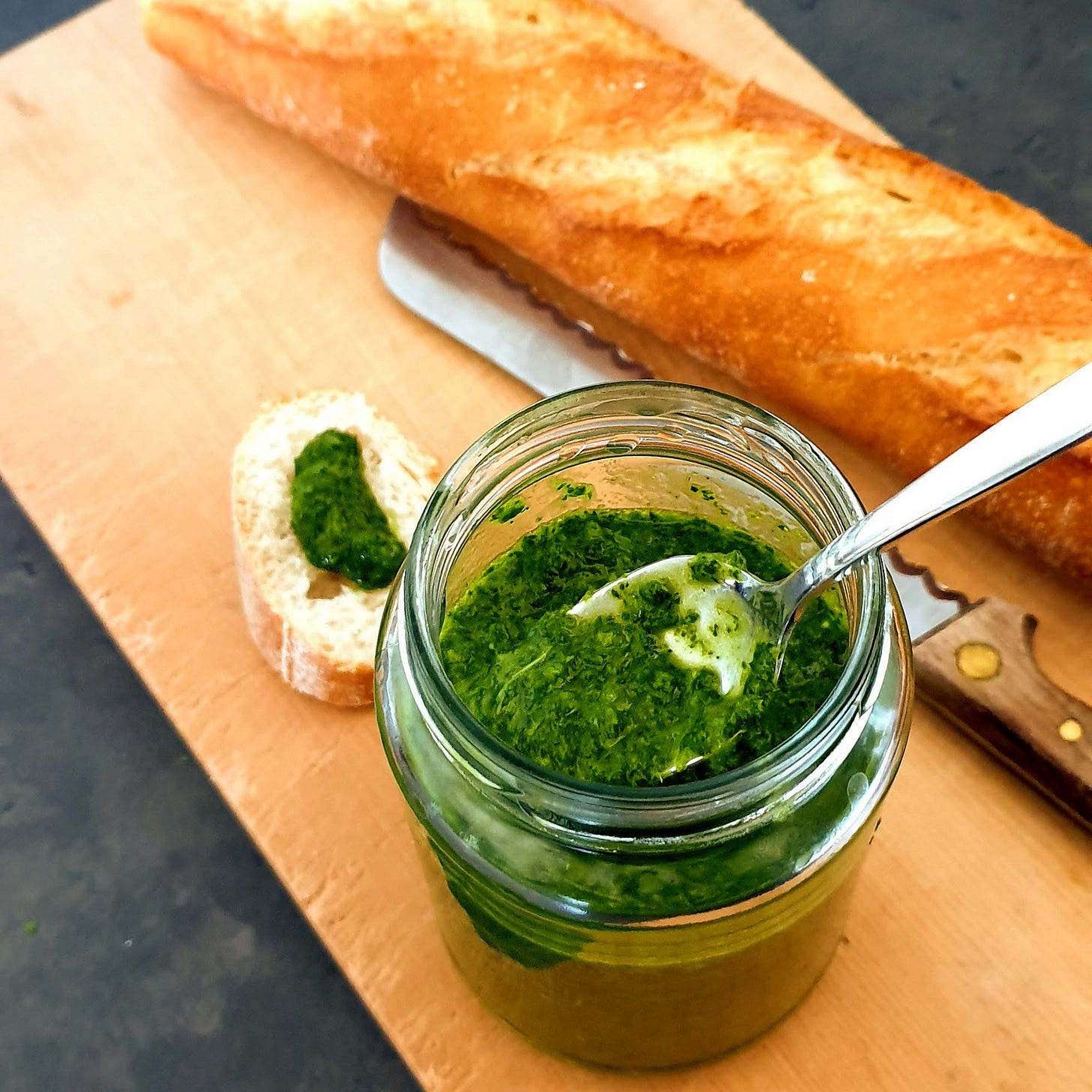

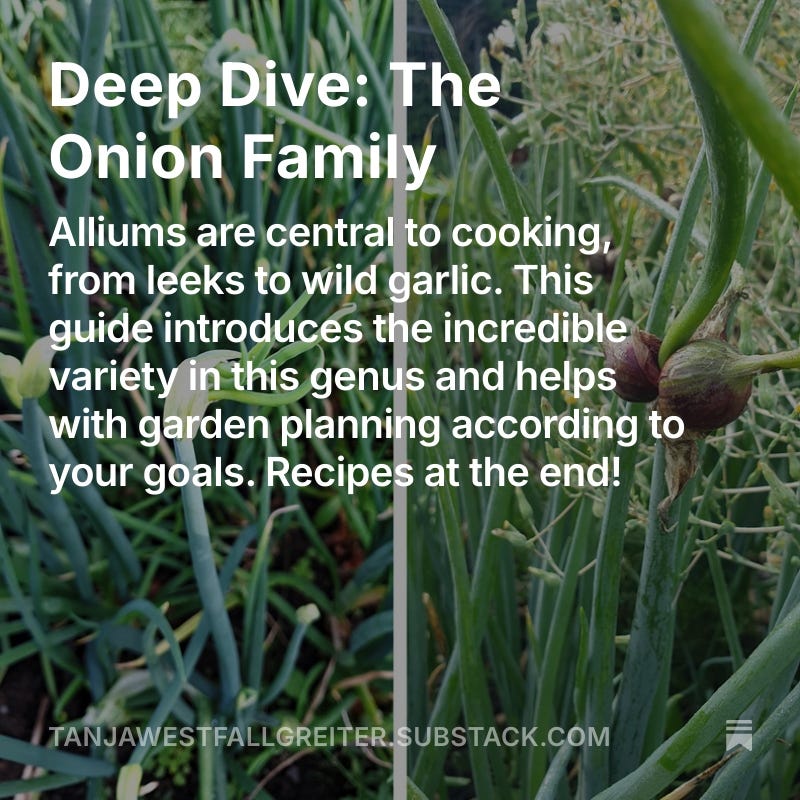
I have enjoyed seeing these images of your far away garden. We've had a much colder winter this year than any in the past several years have been. Not much is waking up here yet. It's nice to see you enjoying and appreciating late winter treats.
I love that hybrid kale! When this cross of brussels and kale was quite trendy, I bought seeds called kalette. It cost 4 euros and inside the packet, to my shock and surprise, were 4 seeds! Out of those 4, one survived and thrived and produced seeds and I will sow them this year. I very much doubt they will breed true but let's see!